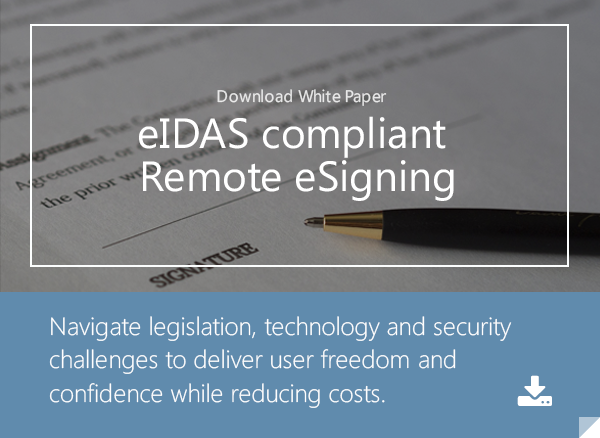3 min read
Introducing the Signature Activation Protocol for Remote Signing
Cryptomathic : 10. September 2022

This article explains the digital Signature Activation Protocol (SAP) in the context of eIDAS-compliant central signing. It sheds light on its purposes and outlines its implementation for remote/central signature servers.
With eIDAS repealing Directive 1999/93/EC, remote electronic signatures have finally received legal recognition. For an electronic signature with the strongest legal value – a qualified electronic signature – the regulation describes requirements for the device that generates and operates the signing key.
Digital Signature Activation Protocol Requirements
Some of these requirements are obvious. For example, attackers shall not have an easy job deriving the signing key value and the signing device must protect the key in a highly secure environment. An important logical requirement is that the signing key shall only be usable by the legitimate owner.
The industry knows very well that by using hardware security modules (HSMs), the obvious requirements can be achieved. The implications for the logical requirement are, however, not widely understood. How is the signatory supposed to securely access a remote HSM to approve a signature operation?
For remote electronic signatures, we use the example of a signatory who wants to sign a document on his/her online device (tablet or laptop). In this case, the user’s device communicates with a remote server that has access to the HSM protecting the signing key.
For physical protection of the signature keys, the keys are generated and used within the secure tamper-protected boundaries of an HSM. To match this highly secure environment, in TS 419 241:2014, it is required that the authorization for activating the signature keys is also carried out inside the HSM. This is illustrated below with the blue arrow from the user device to the HSM.

How Does the Digital Signature Activation Protocol Work?
The protocol that is used to provide a secure digital signature authorization and activation process from the user device to the server and HSM is known as the Signature Activation Protocol (SAP). The purpose of the protocol is to allow the signatory to activate the signing key in the HSM and generate a signature.
The requirements for the SAP are typical for a cryptographic protocol: Confidentiality and integrity of transmitted data must be guaranteed and it must be resistant to attacks like MIM and replay.
In the Signature Activation Protocol, data for activating the signing key for signature operation is transmitted from the user’s device to the HSM. This digital signature activation data must be designed such that it links together information about:
- The signatory
- The document to be signed
- Which key to use if the signatory has several signing keys
The signatory specifies information that the HSM can relate to the signatory account and identify the signatory. Authentication used for signature activation can be as simple as a username/password and an OTP, or more advanced data like a SAML assertion demonstrating the signatory has already been identified.
Regardless of the chosen authentication scheme, the HSM must verify the values; either password and OTP in the simple case or the SAML assertion in the advanced case.
Why These Requirements Are Important
The link is to be taken seriously and is not trivial to solve. The requirement is there to ensure that when the signatory provides his/her authentication credentials, they can only be used for authorizing a signature for the intended document. Without this requirement, one could imagine a SAML assertion being used to sign other documents than the signatory intended.
In support of the European Committee for Standardization (CEN), Cryptomathic has participated in the working group CEN TC224 WG17 and played an active part to establish technical specifications and standards for remote electronic signatures. The published document TS 419 241:2014 describes security requirements for a trustworthy system supporting remote signing and it covers terms and requirements for how the logical requirement can be achieved.
References and Further Reading
- Selected articles on Authentication (2014-16), by Heather Walker, Luis Balbas, Guillaume Forget, Jan Ulrik Kjærsgaard, and Dawn M. Turner
- Selected articles on Electronic Signing and Digital Signatures (2014-16), by Ashiq JA, Guillaume Forget, Jan Ulrik Kjærsgaard, Peter Landrock, Torben Pedersen, Dawn M. Turner and Tricia Wittig
- REGULATION (EU) No 910/2014 on electronic identification and trust services for electronic transactions in the internal market and repealing Directive 1999/93/EC (2014) by the European Parliament and the European Commission
- Recommendations for the Security of Internet Payments (Final Version) (2013), by the European Central Bank
- Draft NIST Special Publication 800-63-3: Digital Authentication Guideline (2016), by the National Institute of Standards and Technology, USA.
- NIST Special Publication 800-63-2: Electronic Authentication Guideline (2013), by the National Institute of Standards and Technology, USA.
- Security Controls Related to Internat Banking Services (2016), Hong Kong Monetary Authority
Image:"portatil-tablet-smartphone", courtesy of MiniYo73, Flickr (CC BY-SA 2.0)
